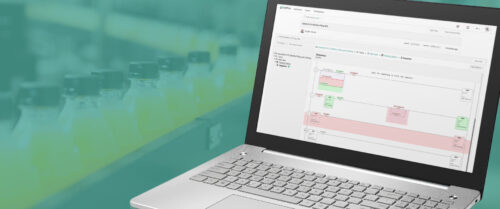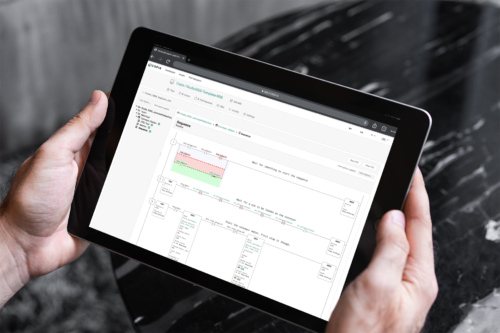Networked motor management system improves boiler cleaning system
Burning fossil fuels efficiently and economically is vital for power companies when it comes to meeting the ever-increasing demand for electricity by a growing world economy. The efficiency of a boiler is determined largely by the cleanliness of its heating transfer surfaces. This is why power companies spend increasingly more effort in modernizing their boiler cleaning systems.
Burning fossil fuels efficiently and economically is vital for power companies when it comes to meeting the ever-increasing demand for electricity by a growing world economy. The efficiency of a boiler is determined largely by the cleanliness of its heating transfer surfaces. This is why power companies spend increasingly more effort in modernizing their boiler cleaning systems.
A leading OEM of advanced boiler cleaning systems, Atlanta-based Clyde Bergemann (CB), offers a full range of boiler onload cleaning solutions for every type of boiler — from individual soot blowers, to more advanced sensor controlled, intelligent boiler cleaning systems.
Intelligent boiler cleaning systems have sensors that monitor boiler cleanliness. These sensors provide information that enables CB’s control system to decide which soot blower cleans next and where. This intelligent system greatly improves boiler efficiency and minimizes downtime.
Simplified installation and maintenance
When searching for motor management solutions for their boiler cleaning equipment, Jim Noland, controls engineer at Clyde Bergemann, was looking for a distributed I/O solution, where individual hardwiring and conduit running to the sootblowers would not be necessary, and basic soot blower operation could be implemented with a local controller. Rather, a single cable would run from a PLC cabinet, daisy chaining to the other sootblowers that could then operate independently if PLC controls were disrupted. “We were interested in a solution that replaced hardwired circuitry. Instead of custom circuits for every type of blower, it meant we could replace all that wiring with one motor management tool,” said Noland.
Having worked with Siemens’ contractors for more than 10 years, and having had good experience with Siemens’ motor control products, Siemens was short listed among other competing distributed I/O system vendors. When Jim Noland and Sandeep Shah, Director of Technology, took a closer look at the Siemens Simocode pro and realized the vast range of extra features it had, the purchase decision was simple.
The new system’s distributed I/O system simplified implementation for Noland and other engineers at Clyde Bergemann. “Instead of maintaining separate circuit designs for each type of blower, we now just program a configuration in the system. The time savings is dramatic,” said Noland. There is a different control scheme for each of the different blowers. For example, a blower is programmed to insert, pause for 0.8 seconds and retract. Instead of hardwiring that logic, it can now just be programmed. Any changes to that logic can be made in a matter of seconds instead of a lengthy process involved with hard wiring; there is no interruption to the production. “Not only did we find our desired distributed I/O but we also found one that makes configuration and programming easy. And the system connects seamlessly to Profibus and has a very simple interface,” continued Noland.
It was the Profibus interface and its high degree of detail on the performance of the blowers that was the key decision factor in favor of the Simocode pro. While conventional systems only show the cycle time, and whether the system is in run or fault, the Siemens motor management system shows much more. It transmits actual motor current, motor direction, phase status and overload status back to the PLC. “This was a major benefit for us; you can monitor a lot more detail on the motor status than you can on a conventional control system,” Shah said. For example, if the current starts to get too high, you can perform proactive preventive maintenance before the blower shuts down.
As with any industrial operating machine, reliability is vital. Most critical systems must be fail-safe. When a soot blower fails, then a part of the boiler cannot be cleaned, and combustion residues are deposited on both the heating surfaces and the heat exchangers, which inhibits heat transfer and therefore reducing the boiler’s efficiency. It is vital for Clyde Bergemann to provide a system that is reliable to ensure the boiler remains efficient and the soot deposits are continuously removed.
Safety and reliability
Though Clyde Bergemann knew it wanted a distributed I/O solution, it also knew it could not depend completely on the PLC for safety precautions. “The first question that always arises when distributed I/O interfaces are considered is what happens if the communication cable connection is disrupted. The fact that [this system] will execute its own logic internally really caught my attention as [this solution] allows for local programming and local control. It means we can at least operate manually from the sootblower junction box even if the Profibus cable is cut or disturbed or the controller is not communicating to the device,” Shah said.
Another safety and reliability area where this system has an edge over the previous system design is its ability to detect problems with the limit switch. This meant that Clyde Bergemann could actively monitor its soot blowers instead of reacting when one of them would happen to stop suddenly due to a failed limit switch. “Previously, the PLC was not able to monitor the limit switch inputs on the blower. If a limit switch failed, we would not know until the blower had started and its cycle time was exceeded. Now we can monitor blower I/O status and automatically disable a blower if a problem exists,” Noland said.
“[This system] puts us a step ahead of the competition because of its extra features and diagnosis capabilities,” commented Sandeep Shah.
One final benefit which became apparent after the system was installed was that it had built in integrated motor safety protection. This provides instant disabling of the starter outputs if an overload or fault condition is detected as well as reversing and other integrated protection. The advantage is that protection logic does not have to be handled by the PLC. I/O points are not consumed with monitoring individual overloads. Overload trips can be reset from the HMI. Overload warning and trip configuration allow different programs to be configured based on the severity of the overload. For example, in a typical overload condition, the blower should immediately retract and not trip to prevent the expensive boiler from being damaged. However, for a stalled rotor condition, the starter should not trip to prevent damage to the drive train. This level of configuration is not possible with a standard control system. It would require additional programming or hardwiring.
Noland sums up: “The Simocode pro really exceeded our expectations; it does what it promotes and more. It is simple to program and operates reliably in a harsh environment.”
Information provided by Siemens Energy & Automation, Inc., Power Distribution & Controls division, Norcross, GA, www.siemens.com
Do you have experience and expertise with the topics mentioned in this content? You should consider contributing to our CFE Media editorial team and getting the recognition you and your company deserve. Click here to start this process.





